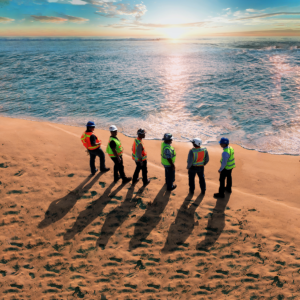A decade since Macondo, industry remains committed to better safety
Notable advances have been made across the industry in well control training, safety culture, cooperation with regulators, and source control and containment
By Stephen Whitfield, Associate Editor
The blowout of the Macondo well in the US Gulf of Mexico in 2010 had a profound impact on the oil and gas industry that is still being felt a decade later. The industry has made significant strides in safety culture since then, with operators, drilling contractors and regulatory bodies all striving toward a world where an incident like this never happens again.
“We’ve drawn on the best minds in industry and government to build a multilayer system with many built-in redundancies to help prevent incidents. The industry is better prepared than ever before,” said Holly Hopkins, API Senior Policy Advisor.
While a perfect world may be impossible to achieve, it’s clear that the industry continues in its quest to try and get as close to zero incidents as possible. Some of the major step changes in safety culture and personnel training took place in the immediate aftermath of the incident, but adjustments to regulations, well design planning protocols and training programs continue to be made, helping companies adapt to the present drilling environment.
Collaborative environment
Significant developments in safety culture over the past decade have come from collaboration between industry and regulators, particularly through enhanced communications among operators, drillers and regulators to reinforce and advance safety measures. Ms Hopkins noted that, since 2010, more than 250 standards for offshore E&P have been created and updated, including standards for safety and environmental management, well design and blowout prevention.
“The cumulative actions industry and regulators have taken over the past decade have only enhanced our safety culture,” Ms Hopkins said. “Operations are safer because our regulations, industry standards and best practices have progressed to keep up with constantly changing environments and situations.”
Last December, API issued a new edition of Recommended Practice 75 that expanded safety and environmental management systems. Among other things, the document now:
- Provides guidance on how companies should interface with each other to ensure that operational risks are managed and safety and environmental protection is maintained;
- Expands the types of operations that fall under safety and environmental risk management (SEMS) expectations, providing greater consideration of human performance;
- Is structured to encourage utilization by contractors and sub-contractors;
- Includes advancements in technology, operations and overall knowledge; and
- Is extended for global use beyond its previous focus on operations on the US Outer Continental Shelf.
In 2018, the Center for Offshore Safety (COS), an API subsidiary, issued guidelines specifically addressing safety culture. The document, Guidelines for a Robust Safety Culture, builds on the Safety Culture Policy Statement issued by the US Bureau of Safety and Environmental Enforcement (BSEE) in 2013, describing specific safety culture characteristics in greater detail so that companies can better assess their organizations.
Ms Hopkins said the document further illustrates the continued focus at the COS on human performance.
“At COS and throughout the industry, we’re continuing to place an emphasis on human factors,” she said. “We’re accounting for the decisions people need to make every day, and that’s of vital importance when we’re talking about safety culture.”
Among other things, the document outlines the value of open communication in the work environment. It says that the broad communication of experiences, either individual or shared, can help increase a company’s collective knowledge of hazards, responses and risks. Building a culture of respect and trust, where personnel feel confident and empowered to contribute honest opinions and knowledge, can also better foster a collaborative environment that supports safety initiatives.
In recent years, BSEE says it has worked to further strengthen respect and trust between regulator and industry by streamlining compliance mechanisms. In 2017, the bureau launched a review of specific regulations, with the intent of revising provisions that create unnecessary regulatory burdens while still ensuring operational safety.
One such revision eliminated the use of BSEE Approved Verification Organizations (BAVOs) and adopted the use of qualified Independent Third Parties (I3Ps) for verifications on BOP systems. BSEE also eliminated the requirement to have a BAVO submit a mechanical integrity assessment report for the BOP stack and system, while still requiring submittal of the I3P’s statement of fact prior to installing a subsea BOP. Craig Castille, Managing Director of HWCG, a consortium of deepwater operators and non-operators focused on well containment in the US Gulf of Mexico, cited this as an example of increased regulatory trust in industry.
“There’s an open dialogue with BSEE. If there’s something new you want to use, or there’s an alternate compliance on a regulation you want to discuss, you need to have dialogue early to ensure there’s a mutual understanding of the technologies’ benefits or the issue with a regulation, then present your case as to why your suggestion is better than what they already have – they will listen to you and provide guidance.”
Founded in 2011, HWCG’s primary focus is the preparation of standardized response plan templates for its members, using source control and containment equipment (SCCE) purchased by HWCG or accessed through agreements with its core contractors. The plans and SCCE are meant to help with responding to deepwater blowouts exclusively in the US Gulf of Mexico. Its well containment plan addresses blowout risks by shortening the duration of the blowout, and provides detailed technical procedures and response protocols for different foreseeable deepwater containment scenarios.
Mr Castille said the risk assessment that often comes from planning for well containment can also help operators identify potential trouble spots. Then, additional mitigations and contingencies can be prepared early while still in the planning stages. He mentioned BSEE’s Well Containment Screening Tool (WCST) as a valuable risk assessment option that essentially serves as a constant check as operators design and construct their wells.
The tool, which is filed on record along with an operator’s drilling application, provides data on geological characteristics, mud line pressure and the mechanical limits of well construction equipment, which helps determine the appropriate capping stack and interfaces needed to cap a well, as well as the contingent flow and capture equipment when a well cannot be shut in. Ostensibly, this helps operators mitigate the impact of an incident, but Mr Castille said the frequent updates to the WCST also promotes improved risk assessment and management throughout the well construction process that can lead to more robust well designs.
Training overhaul
Well control training programs have been a standard in industry for decades, but Macondo emphasized the need for companies to do more to ensure the competency of their rig personnel. “Macondo refocused the industry to get back into training,” said Mark Denkowski, VP of Accreditation Operations at IADC. “In the years since, we’ve overhauled and reviewed how the industry trained in many respects. Well control training needed to change. The system needed to get better. We recognized that, and we made a change.”

IADC has been involved in well control training standards since 1995, when it developed the Well Control Accreditation Program (WellCAP) to help industry professionals deliver well control training that conformed with industry-recognized standards. In 2018, the program transitioned to WellSharp, incorporating standardized tests, metrics for continuous improvement, and quality controls that ensure greater consistency between accrediting bodies.
WellSharp was developed by IADC members representing drilling contractors, operators, well servicing companies, professional trainers and well control specialists, in collaboration with the IADC Well Control Committee. It identifies the knowledge and skills essential to well control knowledge and the skills essential to well control within the context of a specific job position. This means that personnel renewing their training credentials must do so in courses designed for their current role.
Mr Denkowski said the transition from WellCAP to WellSharp has been a major step change in well control training for the industry.
“With WellCAP, we would review an accrediting body, make sure the content was correct, and it was up to their integrity to determine how that test would be delivered. We weren’t going to watch them; we just assumed it would all be OK. With WellSharp, we have a digital test that’s controlled by IADC and our member SMEs. We’ve registered the proctors and the instructors, and we’ve tracked the students. The result is the quality of well control training has taken a big step forward,” Mr Denkowski said.
WellSharp offers courses for drilling operations and well servicing personnel. The drilling operations track is aimed at support personnel who are not directly involved with well control, such as floor hands and derrick workers. The well servicing track is aimed at service company personnel, including field hands, equipment operators and operator representatives involved in workover and well intervention activities.
Mr Denkowski said the fundamentals of the course content have not changed significantly from WellCAP because the physics of well control are the same today as they were in the past. However, IADC has developed the WellSharp Plus program by integrating crew resource management (CRM) into technical well control training, with courses that emphasize problem-solving through teamwork and role play. Participants serve in the different roles needed to make up a rig crew, and the course uses case studies and simulations to provide an opportunity to observe and assess the human factors and technical skills that come up in a given scenario.
Participants in WellSharp Plus must be experienced drilling personnel who have previously earned a Level 3 or 4 WellSharp certificate and have passed the appropriate WellSharp exam with a score of at least 80%. The courses also utilize facilitated learning methods, where the instructor observes activity and, as needed, guides the students through open-ended questions.
Mr Denkowski said the format of the WellSharp Plus course helps maximize knowledge retention by exploiting the human brain’s natural process of learning through experience.
“The conversation in this class is driven from the front, in the sense that the students do all the talking,” he explained. “The CRM professional will have a facilitated conversation about the principles of CRM, then they go through their role play, followed by a technical debrief and a CRM debrief. It’s all about self-learning. There’s no hiding in this class. You will participate. It’s a good facilitator for including everyone in the conversation.” DC





